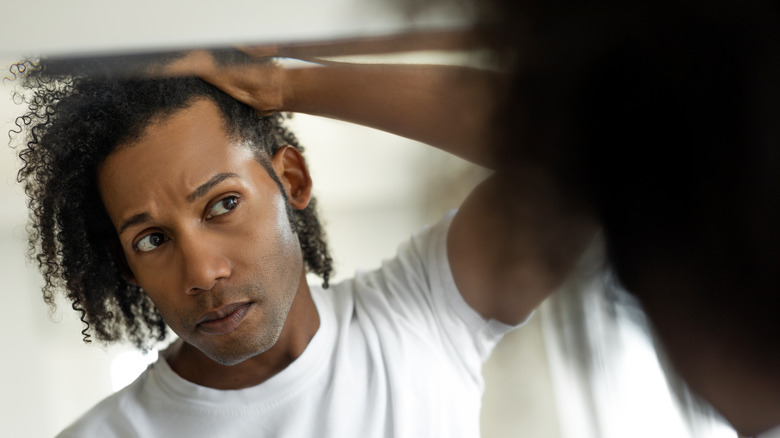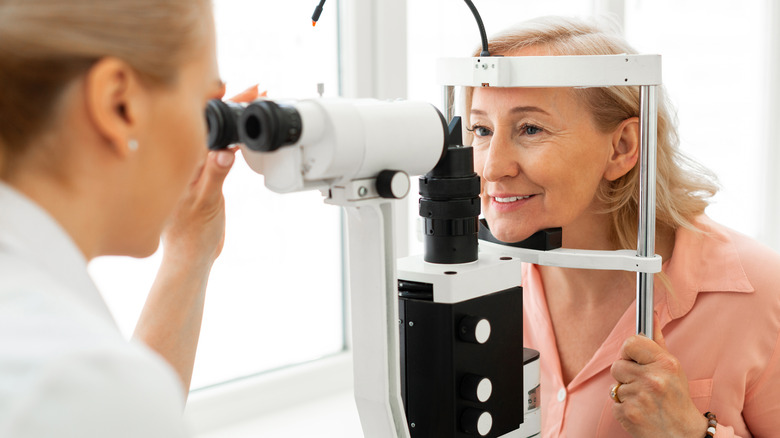Unfortunate Health Drawbacks Of Your Hair Color
Our hair color generally falls into one of five categories: black, brown, white and/or gray, blonde, and once in a blue moon, red, according to News Medical Life Sciences. Our hair color is ultimately bestowed upon us by our genes and how much melanin our cells produce. Those with darker shades of hair have a natural type of melanin known as eumelanin, while people with lighter shades of hair possess pheomelanin.
Just look at any hair care commercial and you'll see smiling spokesmodels showcasing the benefits of any and all hair colors. It's true; no matter the color, each and every one of our luscious manes is uniquely beautiful. Yet research has also discovered certain health drawbacks associated with each and every hair color. These include an increased risk for certain health conditions, cancers, phobias, and more. Let's break down the potential downsides of each hair color category to get a better understanding of how our hair color may influence our health.
People with black or dark brown hair may be more susceptible to depression
There are many sides to mental health, with our genes, biology, lifestyle factors, and social conditions all thought to play a role. In a 2023 literature review published in the Journal of Depression and Anxiety, researchers analyzed the relationship between hair color and symptoms of anxiety and depression. One study found that people with black or dark brown hair were more prone to depression and depressive symptoms of greater severity. Having lighter hair, on the other hand, was more closely correlated with anxiety.
The researchers proposed several theories for this outcome, citing melanin's involvement in the release of serotonin — a neurotransmitter known to influence mood — as one potential mechanism. On the other hand, the relationship between light hair and anxiety may be explained by the fact that sun damage and a lack of vitamin D, two factors that may contribute to anxiety and depression, tend to more often affect those with blonde hair. These findings have not been consistent across the board, however, with other research having found no such connection between hair color and mental health disorders.
Brunettes may be more prone to nicotine addiction
When smoking a cigarette, our brain gets hit with a rush of endorphins as the nicotine activates the reward center of the brain, explains the National Institute on Drug Abuse. This "high" is short-lived, however, leaving tobacco users wanting more in order to achieve the desired effect. People with brown hair, in particular, may be among those left wanting more, science shows.
A 2006 scientific review published in Nicotine & Tobacco Research outlined the underlying mechanisms that may be responsible for this relationship. The researchers explained that nicotine is stored in melanin-containing tissues in the body, which brunettes have more of. Melanin also slows down our nicotine metabolism. As a result, nicotine remains in the body for longer, increasing the risk of addiction. The National Institute on Drug Abuse reports that just 6% of people who smoke cigarettes successfully quit per year.
If you or anyone you know needs help with addiction issues, help is available. Visit the Substance Abuse and Mental Health Services Administration website or contact SAMHSA's National Helpline at 1-800-662-HELP (4357).
Premature graying may increase your risk of heart attack
Going gray is a natural part of life. Premature graying, however, is hair that begins turning gray before the age of 20 for white people and prior to the age of 30 for African American individuals, according to a 2018 scientific review published in the International Journal of Trichology.
Premature graying may occur for any number of reasons and has been linked with vitamin deficiencies, certain autoimmune diseases, the use of certain medications, and smoking. While the research is mixed, several studies have found a correlation between going gray early on and a greater risk of heart attack. One study found this only to be true in men, however, and no link was observed between premature graying and premature death. Other studies have found a connection between early graying and cardiovascular diseases, yet this was not the outcome in other studies. That being said, some research has shown the risk of cardiovascular disease may be higher in people with premature graying who smoke. While the cause of premature graying may be tied to a health issue in some cases, graying related to stress may be reversible.
Blondes may have a higher risk of skin cancer and vision issues
Findings of a 2024 study published in Gene suggest that having a lighter hair color, including blonde, may place a person at greater risk of cutaneous melanoma (CM) and keratinocyte skin cancer (KSC) — both basal cell carcinoma (BCC) and cutaneous squamous cell carcinoma (SCC) fall under the category of KSC. Meanwhile, those with dark brown hair appeared to be at a lower risk for skin cancer, and people with black hair stood at a reduced risk for KSC while there was no relationship found with CM.
Because people with blonde hair tend to have less macular pigment within the eye (particularly if they also have fair skin and light eyes) these individuals may also be at an increased risk of age-related macular degeneration (AMD) as they grow older, explains Pearson Eyecare Group. The more macular pigment a person has, the better protected the macula is from damage caused by free radicals. When the macula becomes damaged due to aging, a person may experience impairment in their central vision, including waves, blurriness, blank spots, or trouble seeing in low-light environments, reports the National Eye Institute.
If you have red hair, you may be more susceptible to melanoma or endometriosis
Last but certainly not least, redheads appear to have some unique health drawbacks of their own. Much like blondes, people with red hair have a greater susceptibility to melanoma by as much as 10 to 100 times that of people with other hair colors, according to the NIH Director's Blog. Why? NIH researchers from a 2013 study published in Molecular Cell found three different elements that may be at play. The first is that people with red hair carry a gene variant that doesn't offer protection from UV-light DNA damage. Second, because of this variant, UV-light exposure also reduces the body's tumor suppressor protein (PTEN). The third factor identified in the study was an additional rare gene mutation, also thought to be prompted by UV rays, that may promote cancerous cell growth.
While the research isn't definitive, people with red hair may also be slightly more vulnerable to endometriosis, a painful condition in which uterine-like tissue grows outside of the uterus, explains the World Health Organization (WHO). Although no significant correlation was identified between red hair and endometriosis in a 2006 longitudinal study published in Fertility and Sterility, researchers did find that women with red hair who had no history of infertility had minimally higher rates of endometriosis over a 10-year follow-up period, while redheads who were infertile saw decreases in endometriosis rates. That being said, further research is still needed on the subject.






